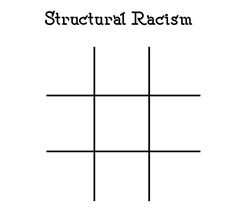One of the things about American culture and society is our racism. It’s not the only thing, or the most important thing (well, maybe). We have a past that is entwined with racism, and there are still problems today with racism.
I won’t go into all the details about racism and what it is in every dimension, because there isn’t the time in this post, nor do I want to completely define everything. I’ll be teaching a class about this in the fall of this year, so if you want a better run-down, sign up.
But I did want to talk about one aspect of racism, and that is “structural racism.” This is perhaps the hardest to see or admit, because we don’t see all the individual acts that lead up to structural racism.
We’re good people, you see, and not racist. We are kind to people who are not like us, we might work with them, and even might have friends who are not exactly like us.
I get that, and I say the same things.
But let’s do a little experiment to understand—or at least demonstrate—what structural racism might look like.
Take a sheet of paper and draw a tic-tac-toe grid:
Now, as best you can, enter the names of the families in your neighborhood—your closest neighbors, whether they are on the same floor as you in your apartment, in your condo development, or your suburban development. Don’t worry about being completely accurate—you might not know the names of the people, so write down something that might fit. You should be able to do this in about 5 or 10 minutes:
Now, as best you can, under their names, write down their occupation. Again, don’t worry too much about the details. Just get a general gist. I wrote down occupations that are what I understand them to be. A “director”, LePage in this case, is the director of a business department:
OK, now the part that might be uncomfortable.
Write down the race of the person or family, to the best of your understanding:
Now, your neighborhood might be slightly different. You might have a few names/races that don’t fit the pattern.
But in general, people in America live sorted by their race.
How did this happen in your neighborhood?
Likely it wasn’t anything deliberate or overt. No one posted signs “White People Only” in your development.
It just happened.
“Look,” you might say. “This is a neighborhood of nice homes. You have to have enough money to pay for them. Some people just don’t have enough wealth to live here.”
“Note that the occupations here all come with good salaries. People working at Walmart can’t afford this place.”
“Most of these people have a good education so they got good jobs. People who do poorly in school because they slack off can’t get good jobs that pay enough to live here.”
And that is structural racism exposed in kind language or “explaining-away” language.
Structural racism is exposed here as a series of steps, all along the way, that leads to sorting by race.
Minority Americans were excluded from access to federally backed mortgages, which meant they could only use financial instruments with far greater risk and far, far less guarantee that they’d end up owning their home or apartment.
Minority Americans historically (and right now, still actually) have access to far fewer education options, and their education options have been and still are substandard when compared to white American education.
Minority Americans are shunted aside to the poorer areas. These poorer areas are historically and currently where we push our most damaging and dirty industries, leading to a poisoned environment which results in sicker children and adults.
Minority Americans have been denied access to careers in businesses where wealth can be acquired, and have also been denied advancement when they do get into businesses.
Minority Americans have had far less safety in their homes and schools and businesses, and when they do have police presence, they are arrested, tried, and imprisoned at far higher rates, for far longer sentences, for crimes that white Americans get by with a warning. (This is literally true. I know you don’t believe it, but there are studies after studies that show similar crimes and similar crime rates for white Americans and black Americans lead to convictions and prison terms for black Americans and a pass or a warning for white Americans.) Prison is literally destructive to families and wealth-building, so minority Americans can’t get the assets they need to move from “starter homes” to better suburbs.
It’s an interlocked system with many components that keep white Americans on top and wealthy, and that blocks minority Americans, especially black Americans, from access to wealth and safety.
Yes, not all white Americans are middle class. And there is a large black middle class, as well as a middle class experience for other minorities.
But it is inarguable that the middle class in America as a whole is much more likely to comprise the white race than any other race.
This is structural racism. Piece by piece we have systems that block minority Americans from access to things white Americans take for granted & think come from “hard work” and “taking chances.”
The people in your neighborhood are probably not overt racists. You are probably not overtly racist. You are probably a nice guy, like me.
Yet your neighborhood shows you as living only among your own kind. The occupations are diverse. But the race is probably uniformly of one kind: yours.
I can’t offer you, right now, options to change that. I just wanted to highlight it, for now, so you can maybe start your journey of understanding America better.
More next time.





